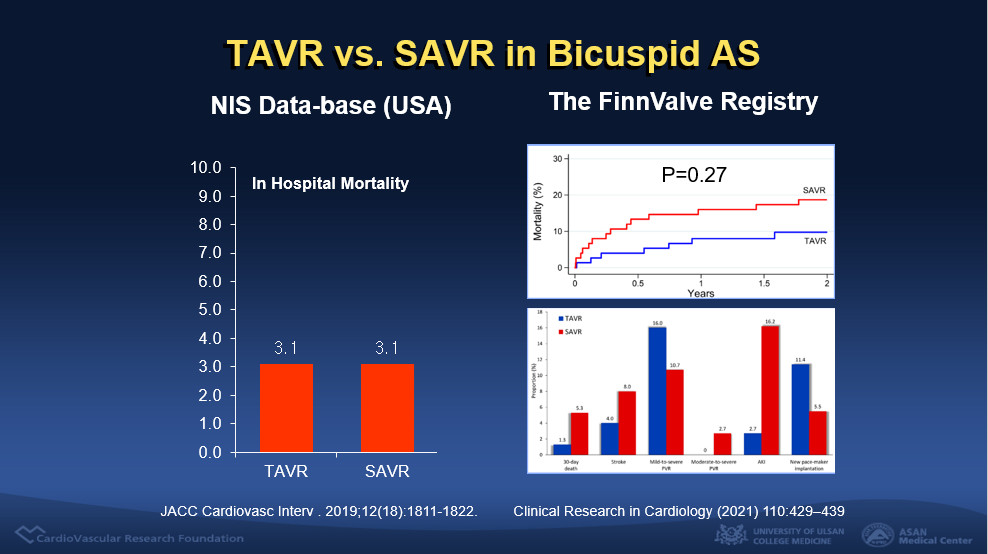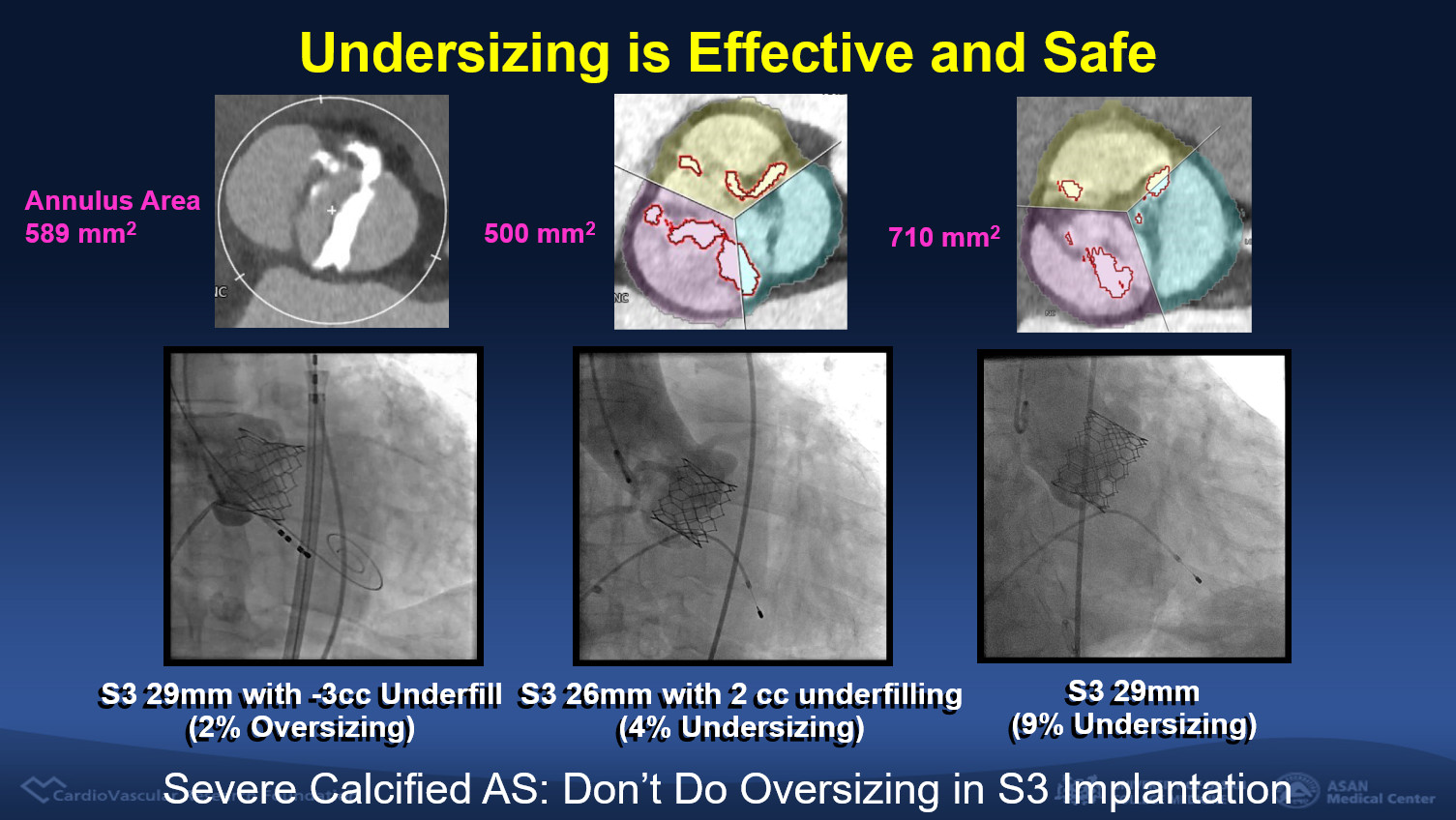News | TCTAP 2024
Bicuspid TAVR: All the Technical Issues and Data from Asan Medical Center
TAVR: Future Perspectives

Jung-Min Ahn
Asan Medical Center, Republic of Korea
Jung-Min Ahn, MD (Asan Medical Center, Seoul, Korea) presented a comprehensive overview of the technical challenges and clinical outcomes associated with transcatheter aortic valve replacement (TAVR) in patients with bicuspid aortic stenosis (AS) from Asan Medical Center.
Ahn highlighted the clinical and anatomical challenges of treating bicuspid AS with TAVR, emphasizing that clinical evidence is still limited. He referenced a large dataset of 12,000 patients, comparing outcomes between bicuspid and tricuspid aortic valve TAVR. The data showed no significant differences in hard endpoints, though bicuspid TAVR was associated with an increased risk of paravalvular leak (PVL) and aortic root injury.
One key discussion point was comparing TAVR and surgical aortic valve replacement (SAVR) in bicuspid aortic valve stenosis. While some studies showed no difference in mortality, others suggested numerically higher risk with SAVR, though this was not statistically significant (Figure 1). Device-specific outcomes were also discussed, noting that self-expandable devices had a higher risk of moderate or significant PVL, whereas balloon-expandable devices were associated with a higher risk of annulus rupture and aortic root injury.

Figure 1. Comparison of TAVR and SAVR in bicuspid AS
Ahn emphasized the importance of calcification in bicuspid valves. These valves often have a higher amount of calcium compared to tricuspid valves, which may lead to higher procedural risks. It was also pointed out that younger patients typically have a higher incidence of bicuspid AS, while it’s not as common in older age groups.
The presentation also included data on device sizing. Most bicuspid valves fall into tubular and flare types, which allow for device sizing based on annular size in 90% of cases. Ahn primarily focused on the Sapien 3 device, noting its effectiveness when sized correctly. He stressed the importance of avoiding oversizing in cases of severe calcification to reduce the risk of complications (Figure 2).

Figure 2. Importance of avoiding oversizing in cases of severe calcification
Ahn concluded that bicuspid AS has distinct clinical and phenotypical characteristics, such as younger patient age, more severe aortic valve calcification, and associated aortopathy. The incidence of paravalvular leak is higher compared to tricuspid aortic valve cohorts undergoing TAVR, and caution should be exercised regarding aortic injury. Despite these challenges, TAVR for bicuspid AS is not associated with an excess risk of mortality and stroke. Sapien 3 implantation in bicuspid aortic valves is comparable to its use in tricuspid valves. Therefore, there is a need to define specific criteria for selecting patients with bicuspid aortic stenosis who can be successfully treated with TAVR, much like the Echo-Score for rheumatic mitral stenosis.
Hot Topics
TAVR: Future Perspectives
Saturday, April 27, 9:00 AM ~ 10:34 AM
Valve & Endovascular Theater, Level 2
Edited by

Junghoon Lee, MD
Catholic university of Korea, Eunpyeong St. Mary's hospital, Korea (Republic of)

Jung-Min Ahn
Asan Medical Center, Republic of Korea
Jung-Min Ahn, MD (Asan Medical Center, Seoul, Korea) presented a comprehensive overview of the technical challenges and clinical outcomes associated with transcatheter aortic valve replacement (TAVR) in patients with bicuspid aortic stenosis (AS) from Asan Medical Center.
Ahn highlighted the clinical and anatomical challenges of treating bicuspid AS with TAVR, emphasizing that clinical evidence is still limited. He referenced a large dataset of 12,000 patients, comparing outcomes between bicuspid and tricuspid aortic valve TAVR. The data showed no significant differences in hard endpoints, though bicuspid TAVR was associated with an increased risk of paravalvular leak (PVL) and aortic root injury.
One key discussion point was comparing TAVR and surgical aortic valve replacement (SAVR) in bicuspid aortic valve stenosis. While some studies showed no difference in mortality, others suggested numerically higher risk with SAVR, though this was not statistically significant (Figure 1). Device-specific outcomes were also discussed, noting that self-expandable devices had a higher risk of moderate or significant PVL, whereas balloon-expandable devices were associated with a higher risk of annulus rupture and aortic root injury.

Ahn emphasized the importance of calcification in bicuspid valves. These valves often have a higher amount of calcium compared to tricuspid valves, which may lead to higher procedural risks. It was also pointed out that younger patients typically have a higher incidence of bicuspid AS, while it’s not as common in older age groups.
The presentation also included data on device sizing. Most bicuspid valves fall into tubular and flare types, which allow for device sizing based on annular size in 90% of cases. Ahn primarily focused on the Sapien 3 device, noting its effectiveness when sized correctly. He stressed the importance of avoiding oversizing in cases of severe calcification to reduce the risk of complications (Figure 2).

Ahn concluded that bicuspid AS has distinct clinical and phenotypical characteristics, such as younger patient age, more severe aortic valve calcification, and associated aortopathy. The incidence of paravalvular leak is higher compared to tricuspid aortic valve cohorts undergoing TAVR, and caution should be exercised regarding aortic injury. Despite these challenges, TAVR for bicuspid AS is not associated with an excess risk of mortality and stroke. Sapien 3 implantation in bicuspid aortic valves is comparable to its use in tricuspid valves. Therefore, there is a need to define specific criteria for selecting patients with bicuspid aortic stenosis who can be successfully treated with TAVR, much like the Echo-Score for rheumatic mitral stenosis.
Hot Topics
TAVR: Future Perspectives
Saturday, April 27, 9:00 AM ~ 10:34 AM
Valve & Endovascular Theater, Level 2
Edited by

Junghoon Lee, MD
Catholic university of Korea, Eunpyeong St. Mary's hospital, Korea (Republic of)

Leave a comment